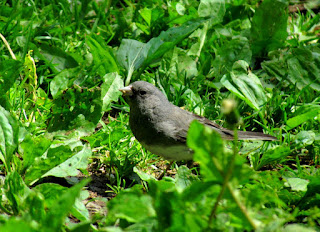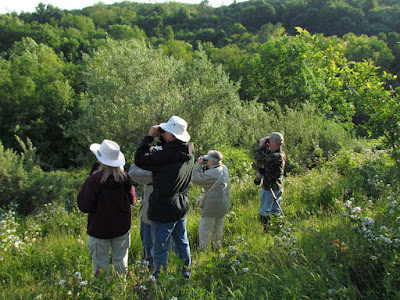I've got a challenge for all you birders out there that involves nothing more than you, your binoculars, your favorite field guide, and eBird.
 |
| This Hairy Woodpecker is listening... |
What is this eBird thing, you ask. Let’s allow the folks at
eBird themselves to answer:
“A real-time,
online checklist program, eBird has revolutionized the way that the birding
community reports and accesses information about birds. Launched in 2002 by the
Cornell Lab of Ornithology and National Audubon Society, eBird provides rich
data sources for basic information on bird abundance and distribution at a
variety of spatial and temporal scales.”
 |
| Some ducks from my life list. A life list is like a collection of awesome memories, isn't it? |
Reduced to its most basic utility, eBird is a fun and
convenient way to maintain your personal birding lists. Your life list, year
lists, month lists, and numerous geographic lists are there for your perusal
and updated automatically every time you enter a bird sighting. Have you seen
more birds in Comnache County, Oklahoma or Grand Isle County, Vermont? eBird
can tell you in a second, as well as every sighting you’ve ever had at specific
locations in those counties.
 |
| My county lists. County birding is soooo much easier with eBird. |
That can be a lot of fun, but it’s also a treat to use eBird
to help locate birds. Let’s say you find yourself in southern Arizona in
September of 2011 and you want to add a Lucy’s Warbler to your life list. Have
any been seen in the area this month, and if so, where? A quick check of eBird
reveals the answers.
 |
| Lucy's Warbler sightings in south-central Arizona in September 2011. (eBird screen shot) |
If all of that isn’t enough, consider that every sighting
you enter at eBird is a contribution to science. Ornithologists use the data
collected there for myriad reasons, not the least of which could be in studies
to determine migration and nesting patterns and the need to protect vulnerable
habitat. It’s one of the finest examples of citizen science you can find. If
you’re a birder, you are a citizen
and a scientist already, you know.
 |
| Happy Scientist. |
Consider this: You’re on a leisurely sea kayak trip on an
early fall day. You’ve paddled out to False Cape State Park in Virginia and put-in
for lunch on the barrier island’s beach. There you spot a pair of Buff-breasted
Sandpipers. No other humans are in sight. You are now the sole possessor of
some data. The species of bird, number of individuals, precise location, and
time and date of appearance are all data that you, and only you, possess. Feeling
some responsibility to share this newfound treasure? You should be! When those
data are entered at eBird along with all the other sightings of Buff-breasted
Sanpipers for the fall, a picture (literally!) of that species’ fall migration
appears. Your sighting alone may seem insignificant, and it’s true that the
vast majority of bird observation data are not very valuable in a vacuum. But
combine those with millions of other records and the existing data become
stronger and stronger with every new entry.
 |
| "Here's what I want you to do..." |
So, here’s my challenge to you. If you haven’t signed up at
eBird or haven’t used it much, I’d like you to become an active user and try to
enter at least 365 checklists in 2012. But that’s a checklist for every day of
the year, you cry! Yes, but it’s not as difficult as you’d think. (For one
thing, there are 366 days in 2012, so it’s not even one per day, but that’s
splitting hairs.) With jobs and kids and life and weather it’s impossible to go
birding every single day of the year. But 365 checklists doesn’t mean 365 days.
I entered twelve checklists for one 6-hour birding trip in November this year.
These aren’t day lists, but rather checklists of sightings at fairly specific
locations for relatively short periods of time.
Here are some tricks to easily get to 365.
One way is to enter Sunday yard birds. Spend 15 minutes
counting birds in your yard every Sunday morning. Who doesn’t love relaxing
like that? And with virtually no effort, you have 52 checklists for the year
without leaving the house.
 |
| Birding doesn't have to be an adventure every time. aka Gratuitous Angelina Jolie picture to generate blog visits. |
You also have to start appreciating, and recording the
seemingly mundane lists. Do you pass a pond on the way to work every morning?
On most mornings does it have a few Mallards and a Great Blue Heron? In most of
the country that would be something to yawn at. At eBird, that’s valuable
information. Stop for five minutes, see what else you see, and enter the list!
Who cares if the ducks and heron are all that’s on the list? Those are data
that serve to make the entire body of data more valuable. A five or ten minute
observation is all it takes. Two hundred of those counts may total about 20
hours of your entire year. Is 20 hours
spent watching birds in nature all that bad?
 |
| Common as dirt...and you should count 'em and list 'em! |
And now you only need about a hundred more lists to hit the
goal. If you go out actually birding once a week, and enter an average of two checklists
for a morning bird walk, you’re going to hit the goal. If you take a weekend
drive, ten lists in a day isn’t uncommon.
And we haven’t even added in the incidental sightings while
driving or looking out the window of a restaurant. We birders like to say that
we’re always birding, at least while awake. If that’s the case, 365 lists at
eBird in 2012 should be a piece of cake.
Do it for the ornithologists. Do it for you. But most
importantly, do it for the birds. Are you up for this challenge?
Comment below and let me know if you're in!













































